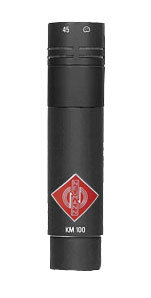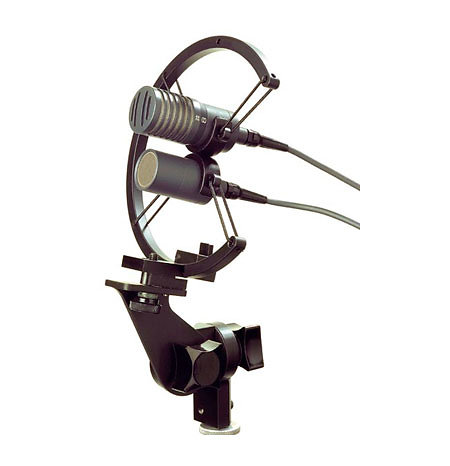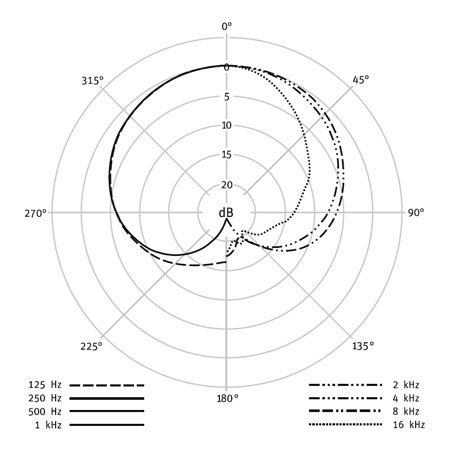Neumann - KM 145
This product is no longer available for sale
These models in stock might interest you:
815,83 €
Static Microphone
Neumann KM 145 Micro Modular cardioid with bass rolloff microphone natural compensation for the proximity effect
ARTICLE N° 26715
Specifications
-
Micro Neumann KM 145
-
Very good tonal balance to a source close to a spoken voice for radio, TV, film and video
-
Very loyal Restitution bass instruments
-
Acoustic Principle Gradient
-
Cardioid
-
Frequency response 20 Hz - 20 kHz
-
Sensitivity at 1 kHz into 1 kohm 15 mV / Pa
-
Nominal impedance 50 ohms
-
Nominal Load Impedance 1000 ohms
-
Equivalent CCIR 468-3 26 dB SPL
-
Equivalent SPL DIN / IEC 651-A 17 dB
-
S / N ratio CCIR 468-3 68 dB
-
S / N ratio DIN / IEC 77 651 dB
-
Maximum SPL for 0.5% THD 138 dB
-
Maximum SPL for 0.5% THD with préatt. 148 dB
-
Output level max. 2540 mV
-
Dyn. mic preamp DIN / IEC 651 122 dB
-
Supply voltage 48 V ± 4 V
-
Consumption 2 mA
-
XLR connector 3
-
Weight 80
Presentation
System of miniature microphones, great flexibility for professional users. An extensive range of accessories ensures optimum adaptation to very different needs. Seven different capsules are available.
This miniature condenser microphones system consists of several capsules, directional characteristics, an output stage, and various accessories.
Today, seven active capsules available: omni diffuse-field equalized for omnidirectional for the free field equalized, cardioid, wide cardioid, cardioid with filtering in severe, hypercardioid and (Figure 8).
Thanks to the modular design of the capsules and the output stage, it is very easy to adapt the system to a wide variety of applications. The microphone is practically invisible, which is a key asset when it is necessary to work with cameras (shooting film or video), on stage, or ceiling suspension (concert hall).
It is also possible to screw directly active capsule on the output stage: we obtain a compact miniature microphone
This miniature condenser microphones system consists of several capsules, directional characteristics, an output stage, and various accessories.
Today, seven active capsules available: omni diffuse-field equalized for omnidirectional for the free field equalized, cardioid, wide cardioid, cardioid with filtering in severe, hypercardioid and (Figure 8).
Thanks to the modular design of the capsules and the output stage, it is very easy to adapt the system to a wide variety of applications. The microphone is practically invisible, which is a key asset when it is necessary to work with cameras (shooting film or video), on stage, or ceiling suspension (concert hall).
It is also possible to screw directly active capsule on the output stage: we obtain a compact miniature microphone
To go further...
AK The capsule 20 is a pressure gradient transducer having a bidirectional directivity (Figure 8), using a single membrane with a diameter of 16 mm. All components of the sound field arrive directly on the membrane. This results in a frequency response and a same output level for the sound effects of 0 ° and 180 °. Specific accessories allow combining the AK 20 with other active capsules to obtain an MS stereo pair.
The capsule AK 30 is an equalized pressure sensor diffuse field, with a flat frequency response up to 10 kHz (in the diffuse field). Free field this microphone has a boost of approximately 7 dB at 10 kHz.
The AK 31 capsule is an equalized pressure sensor in open field, with a flat frequency response up to 20 kHz (in the free field). Free field this microphone has a natural attenuation in acute above 5 kHz.
The capsule AK 40 is a pressure gradient transducer with cardioid. Its response curves are very regular, and correspond to a sound incidence of 0 °. The sounds from sources disposed in a pickup angle of ± 135 ° are reproduced without any coloration.
The capsule AK 43 is a pressure gradient transducer with cardioid widened. The attenuation at 90 ° is 4 dB, 8 dB at 135 °, and of 11 dB at 180 °. Frequency response curves for the sound sources whose incidence is between ± 90 ° are parallel up to 12 kHz.
The AK 45 is a capsule cardioid transducer pressure gradient, similar to the AK 40. However, it has an acoustic attenuation in the bass, useful for applications where the subsonic and low frequencies may cause difficulties. The AK 45 is optimized for flat frequency response in the bass at a distance of 15 cm ("speech cardioid").
The capsule AK 50 is a transducer hypercardioid pressure gradient. The attenuation of sounds arriving from the sides or the back is about 10 dB, the minimum sensitivity at an angle of 120 °.
The capsule AK 30 is an equalized pressure sensor diffuse field, with a flat frequency response up to 10 kHz (in the diffuse field). Free field this microphone has a boost of approximately 7 dB at 10 kHz.
The AK 31 capsule is an equalized pressure sensor in open field, with a flat frequency response up to 20 kHz (in the free field). Free field this microphone has a natural attenuation in acute above 5 kHz.
The capsule AK 40 is a pressure gradient transducer with cardioid. Its response curves are very regular, and correspond to a sound incidence of 0 °. The sounds from sources disposed in a pickup angle of ± 135 ° are reproduced without any coloration.
The capsule AK 43 is a pressure gradient transducer with cardioid widened. The attenuation at 90 ° is 4 dB, 8 dB at 135 °, and of 11 dB at 180 °. Frequency response curves for the sound sources whose incidence is between ± 90 ° are parallel up to 12 kHz.
The AK 45 is a capsule cardioid transducer pressure gradient, similar to the AK 40. However, it has an acoustic attenuation in the bass, useful for applications where the subsonic and low frequencies may cause difficulties. The AK 45 is optimized for flat frequency response in the bass at a distance of 15 cm ("speech cardioid").
The capsule AK 50 is a transducer hypercardioid pressure gradient. The attenuation of sounds arriving from the sides or the back is about 10 dB, the minimum sensitivity at an angle of 120 °.
Neumann - KM 145
Neumann - KM 145
815,83 €
Spotlight on
A legendary brand for decades, present in all the major recording studios, Neumann is a guarantee of high quality and professionalism. The Beatles, Natalie Cole, Celine Dion, Bryan Adams and Beyoncé... all use this exceptional brand with the famous U87, and the TLM49 at the top of the list. In home studio, the TLM103 and TLM102 condenser microphones are the most popular. For studio sound on stage opt for the KMS105. In recent years, Neumann has also offered the high-end KH80, KH120 and KH310 monitors.











